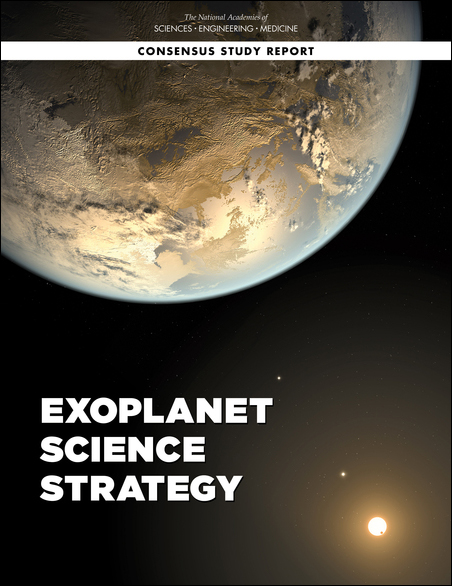National Academies Call for Large Mission to Study Exoplanets

Richard Fienberg Running Hare Observatory
This post is adapted from a National Academies press release:
 To answer significant questions about planetary systems, such as whether our solar system is a rare phenomenon or if life exists on planets other than Earth, NASA should lead a large direct imaging mission — an advanced space telescope — capable of studying Earth-like exoplanets orbiting Sun-like stars, says a new congressionally mandated report by the National Academies of Sciences, Engineering, and Medicine.
To answer significant questions about planetary systems, such as whether our solar system is a rare phenomenon or if life exists on planets other than Earth, NASA should lead a large direct imaging mission — an advanced space telescope — capable of studying Earth-like exoplanets orbiting Sun-like stars, says a new congressionally mandated report by the National Academies of Sciences, Engineering, and Medicine.
The study of exoplanets has seen remarkable discoveries in the past decade. The report identifies two overarching goals in this field of science:
- To understand the formation and evolution of planetary systems as products of star formation and characterize the diversity of their architectures, composition, and environments.
- To learn enough about exoplanets to identify potentially habitable environments and search for scientific evidence of life on worlds orbiting other stars.
Based on these goals, the committee that authored the report found that our current knowledge of the range of characteristics of planets outside the solar system is substantially incomplete. A holistic approach to studying habitability in exoplanets, using both theory and observations, will ultimately be required to search for evidence of past and present life elsewhere in the universe.
While the committee recognized that developing a direct imaging capability will require large financial investments and a long time scale to see results, the effort will foster the development of the scientific community and technological capacity to understand myriad worlds. To detect a system analogous to our own Earth-Sun system, the report recommends using instruments that enable direct imaging of an exoplanet by blocking the light emitted by the parent stars — such as a coronagraph or starshade.
In addition, ground-based astronomy — enabled by two new US-led telescopes — will also play a pivotal role in studying planet formation and potentially terrestrial worlds, the report says. The future Giant Magellan Telescope (GMT) and proposed Thirty Meter Telescope (TMT) would allow profound advances in imaging and spectroscopy of entire planetary systems. They also could detect molecular oxygen in temperate terrestrial planets in transit around close and small stars, the report says.
The committee pointed out that the technology road map to enable the full potential of GMT and TMT in the study of exoplanets is in need of investments and should leverage the existing network of US centers and laboratories. To that end, the report recommends that the National Science Foundation (NSF) invest in both telescopes and their exoplanet instrumentation to provide all-sky access to the US community.
While missions like Kepler have characterized a remarkable population of planets relatively close to their stars, our knowledge of worlds in the outer reaches of the universe is woefully lacking, the committee said. The report says that the Wide Field Infrared Survey Telescope (WFIRST), the large space-based mission that received the highest priority in the Academies' 2010 decadal survey, will play two extremely valuable roles. First, it will permit a survey of planets farther from their stars than surveyed by Kepler and other missions. Second, it will enable a large direct imaging mission.
Although the radial velocity method will continue to provide essential mass and orbit information, its measurements are currently limited by variations in the surface of the star and imperfect calibration of the instruments, the report says. New instruments installed on large telescopes, substantial allocations of observing time, and collaboration between observers and theorists are some of the requirements for progress. To develop these methods and facilities for measuring the masses of temperate terrestrial planets orbiting Sun-like stars, NASA and the NSF should establish a strategic initiative in extremely precise radial velocities.
In addition, NASA should create a mechanism to systematically collect data on exoplanet atmospheres early in the James Webb Space Telescope (JWST) mission. The committee also recommended building on the model of NASA's interdisciplinary collaboration initiative — Nexus for Exoplanet Science System — by supporting a cross-divisional research effort inviting proposals for interdisciplinary research.
The committee called on NASA to support a robust individual investigator program that includes grants for theoretical, laboratory, and ground-based telescopic investigations to fully realize the scientific payoff of exoplanet missions. The report also recognizes that discrimination and harassment exist in the scientific workforce and can affect the exoplanet research community, posing barriers to the participation of people from certain demographic groups. To maximize scientific potential and opportunities for excellence, institutions and organizations should take concrete steps to eliminate discrimination and harassment and to proactively recruit and retain scientists from underrepresented groups.
For more information, see the National Academies press release and the full committee report.

